Quick filters:
Sultanganj buddha Stock Photos and Images
 Copper statue of The Sultanganj Buddha from the Gupta Period. From Bihar, north India. Dated 650 AD Stock Photohttps://www.alamy.com/image-license-details/?v=1https://www.alamy.com/stock-photo-copper-statue-of-the-sultanganj-buddha-from-the-gupta-period-from-90853612.html
Copper statue of The Sultanganj Buddha from the Gupta Period. From Bihar, north India. Dated 650 AD Stock Photohttps://www.alamy.com/image-license-details/?v=1https://www.alamy.com/stock-photo-copper-statue-of-the-sultanganj-buddha-from-the-gupta-period-from-90853612.htmlRMF7PMKT–Copper statue of The Sultanganj Buddha from the Gupta Period. From Bihar, north India. Dated 650 AD
 the Sultanganj buddha in the buddha gallery Birmingham museum and art gallery UK Stock Photohttps://www.alamy.com/image-license-details/?v=1https://www.alamy.com/stock-photo-the-sultanganj-buddha-in-the-buddha-gallery-birmingham-museum-and-86316160.html
the Sultanganj buddha in the buddha gallery Birmingham museum and art gallery UK Stock Photohttps://www.alamy.com/image-license-details/?v=1https://www.alamy.com/stock-photo-the-sultanganj-buddha-in-the-buddha-gallery-birmingham-museum-and-86316160.htmlRMF0C140–the Sultanganj buddha in the buddha gallery Birmingham museum and art gallery UK
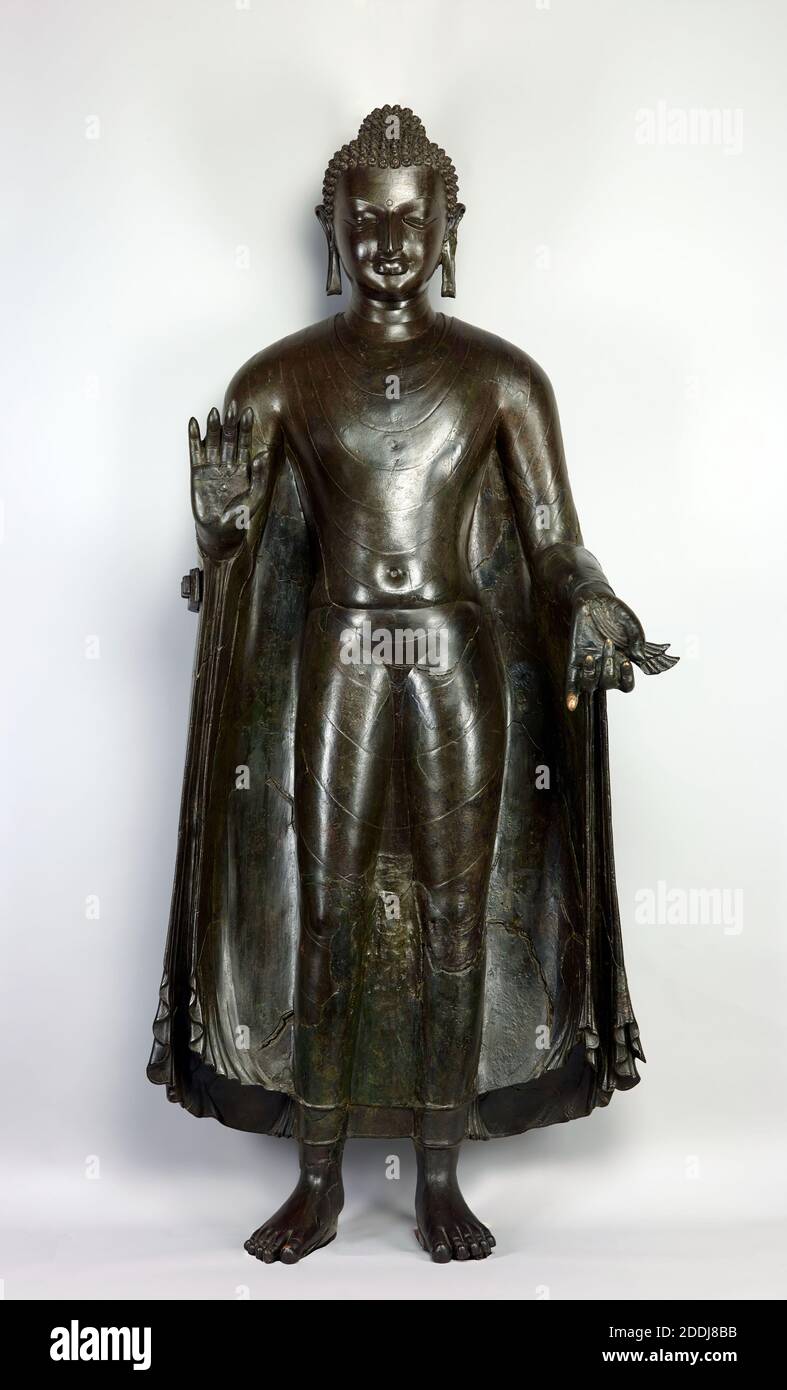 The Sultanganj Buddha, made in India c700. Cast by the lost-wax technique on a clay core, this statue was excavated by E B Harris, a railway engineer, at Sultanganj in northern India during the course of railway construction in 1862. Bronze, Antiquities, Religion, Bhuddism, Sculpture Stock Photohttps://www.alamy.com/image-license-details/?v=1https://www.alamy.com/the-sultanganj-buddha-made-in-india-c700-cast-by-the-lost-wax-technique-on-a-clay-core-this-statue-was-excavated-by-e-b-harris-a-railway-engineer-at-sultanganj-in-northern-india-during-the-course-of-railway-construction-in-1862-bronze-antiquities-religion-bhuddism-sculpture-image387020351.html
The Sultanganj Buddha, made in India c700. Cast by the lost-wax technique on a clay core, this statue was excavated by E B Harris, a railway engineer, at Sultanganj in northern India during the course of railway construction in 1862. Bronze, Antiquities, Religion, Bhuddism, Sculpture Stock Photohttps://www.alamy.com/image-license-details/?v=1https://www.alamy.com/the-sultanganj-buddha-made-in-india-c700-cast-by-the-lost-wax-technique-on-a-clay-core-this-statue-was-excavated-by-e-b-harris-a-railway-engineer-at-sultanganj-in-northern-india-during-the-course-of-railway-construction-in-1862-bronze-antiquities-religion-bhuddism-sculpture-image387020351.htmlRM2DDJ8BB–The Sultanganj Buddha, made in India c700. Cast by the lost-wax technique on a clay core, this statue was excavated by E B Harris, a railway engineer, at Sultanganj in northern India during the course of railway construction in 1862. Bronze, Antiquities, Religion, Bhuddism, Sculpture
 2m,7th century,Sultanganj Buddha,Birmingham Museum and Art Gallery,Chamberlain Square,Birmingham,West Midlands,Midlands,England,UK,GB,Britain,Europe Stock Photohttps://www.alamy.com/image-license-details/?v=1https://www.alamy.com/2m7th-centurysultanganj-buddhabirmingham-museum-and-art-gallerychamberlain-squarebirminghamwest-midlandsmidlandsenglandukgbbritaineurope-image328308595.html
2m,7th century,Sultanganj Buddha,Birmingham Museum and Art Gallery,Chamberlain Square,Birmingham,West Midlands,Midlands,England,UK,GB,Britain,Europe Stock Photohttps://www.alamy.com/image-license-details/?v=1https://www.alamy.com/2m7th-centurysultanganj-buddhabirmingham-museum-and-art-gallerychamberlain-squarebirminghamwest-midlandsmidlandsenglandukgbbritaineurope-image328308595.htmlRM2A23MXY–2m,7th century,Sultanganj Buddha,Birmingham Museum and Art Gallery,Chamberlain Square,Birmingham,West Midlands,Midlands,England,UK,GB,Britain,Europe
 The Sultanganj Buddha, 500-700. Artist unknown.. Cast by the lost-wax technique on a clay core, this 6th to 7th Century bronze statue was excavated by E B Harris, a railway engineer, at Sultanganj, the state of Bihar, in northern India during the course of railway construction in 1862. Stock Photohttps://www.alamy.com/image-license-details/?v=1https://www.alamy.com/the-sultanganj-buddha-500-700-artist-unknown-cast-by-the-lost-wax-technique-on-a-clay-core-this-6th-to-7th-century-bronze-statue-was-excavated-by-e-b-harris-a-railway-engineer-at-sultanganj-the-state-of-bihar-in-northern-india-during-the-course-of-railway-construction-in-1862-image551007910.html
The Sultanganj Buddha, 500-700. Artist unknown.. Cast by the lost-wax technique on a clay core, this 6th to 7th Century bronze statue was excavated by E B Harris, a railway engineer, at Sultanganj, the state of Bihar, in northern India during the course of railway construction in 1862. Stock Photohttps://www.alamy.com/image-license-details/?v=1https://www.alamy.com/the-sultanganj-buddha-500-700-artist-unknown-cast-by-the-lost-wax-technique-on-a-clay-core-this-6th-to-7th-century-bronze-statue-was-excavated-by-e-b-harris-a-railway-engineer-at-sultanganj-the-state-of-bihar-in-northern-india-during-the-course-of-railway-construction-in-1862-image551007910.htmlRM2R0CG5X–The Sultanganj Buddha, 500-700. Artist unknown.. Cast by the lost-wax technique on a clay core, this 6th to 7th Century bronze statue was excavated by E B Harris, a railway engineer, at Sultanganj, the state of Bihar, in northern India during the course of railway construction in 1862.
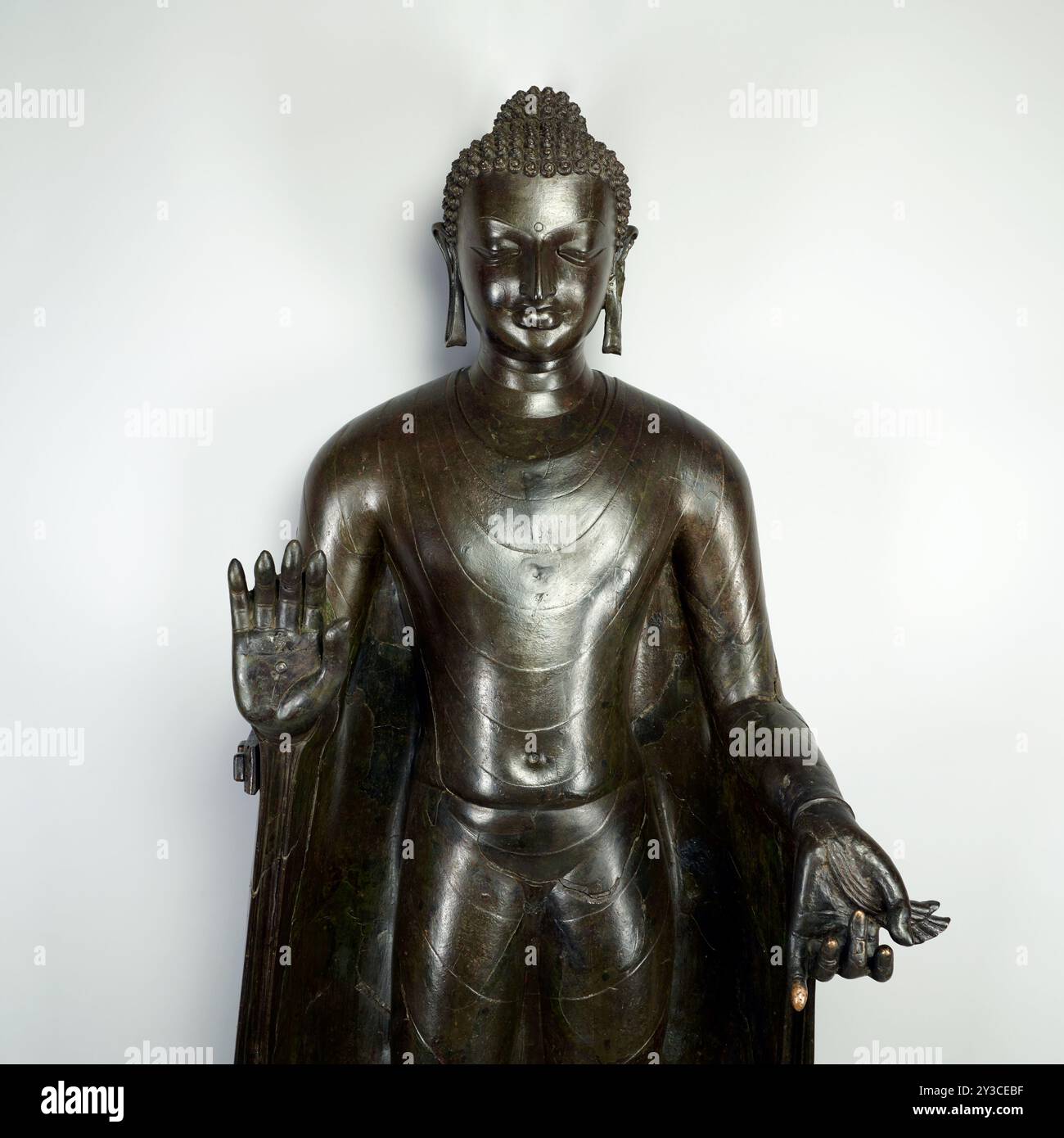 The Sultanganj Buddha, 500-700. Stock Photohttps://www.alamy.com/image-license-details/?v=1https://www.alamy.com/the-sultanganj-buddha-500-700-image621691939.html
The Sultanganj Buddha, 500-700. Stock Photohttps://www.alamy.com/image-license-details/?v=1https://www.alamy.com/the-sultanganj-buddha-500-700-image621691939.htmlRM2Y3CEBF–The Sultanganj Buddha, 500-700.
 Copper statue of The Sultanganj Buddha from the Gupta Period. From Bihar, north India. Dated 650 AD Stock Photohttps://www.alamy.com/image-license-details/?v=1https://www.alamy.com/stock-photo-copper-statue-of-the-sultanganj-buddha-from-the-gupta-period-from-90853599.html
Copper statue of The Sultanganj Buddha from the Gupta Period. From Bihar, north India. Dated 650 AD Stock Photohttps://www.alamy.com/image-license-details/?v=1https://www.alamy.com/stock-photo-copper-statue-of-the-sultanganj-buddha-from-the-gupta-period-from-90853599.htmlRMF7PMKB–Copper statue of The Sultanganj Buddha from the Gupta Period. From Bihar, north India. Dated 650 AD
 The Sultanganj Buddha, 500-700. Artist unknown.. Cast by the lost-wax technique on a clay core, this 6th to 7th Century bronze statue was excavated by E B Harris, a railway engineer, at Sultanganj, the state of Bihar, in northern India during the course of railway construction in 1862. Stock Photohttps://www.alamy.com/image-license-details/?v=1https://www.alamy.com/the-sultanganj-buddha-500-700-artist-unknown-cast-by-the-lost-wax-technique-on-a-clay-core-this-6th-to-7th-century-bronze-statue-was-excavated-by-e-b-harris-a-railway-engineer-at-sultanganj-the-state-of-bihar-in-northern-india-during-the-course-of-railway-construction-in-1862-image551007812.html
The Sultanganj Buddha, 500-700. Artist unknown.. Cast by the lost-wax technique on a clay core, this 6th to 7th Century bronze statue was excavated by E B Harris, a railway engineer, at Sultanganj, the state of Bihar, in northern India during the course of railway construction in 1862. Stock Photohttps://www.alamy.com/image-license-details/?v=1https://www.alamy.com/the-sultanganj-buddha-500-700-artist-unknown-cast-by-the-lost-wax-technique-on-a-clay-core-this-6th-to-7th-century-bronze-statue-was-excavated-by-e-b-harris-a-railway-engineer-at-sultanganj-the-state-of-bihar-in-northern-india-during-the-course-of-railway-construction-in-1862-image551007812.htmlRM2R0CG2C–The Sultanganj Buddha, 500-700. Artist unknown.. Cast by the lost-wax technique on a clay core, this 6th to 7th Century bronze statue was excavated by E B Harris, a railway engineer, at Sultanganj, the state of Bihar, in northern India during the course of railway construction in 1862.
 The Sultanganj Buddha, 500-700. Stock Photohttps://www.alamy.com/image-license-details/?v=1https://www.alamy.com/the-sultanganj-buddha-500-700-image621691841.html
The Sultanganj Buddha, 500-700. Stock Photohttps://www.alamy.com/image-license-details/?v=1https://www.alamy.com/the-sultanganj-buddha-500-700-image621691841.htmlRM2Y3CE81–The Sultanganj Buddha, 500-700.
 Copper statue of The Sultanganj Buddha from the Gupta Period. From Bihar, north India. Dated 650 AD Stock Photohttps://www.alamy.com/image-license-details/?v=1https://www.alamy.com/stock-photo-copper-statue-of-the-sultanganj-buddha-from-the-gupta-period-from-90853607.html
Copper statue of The Sultanganj Buddha from the Gupta Period. From Bihar, north India. Dated 650 AD Stock Photohttps://www.alamy.com/image-license-details/?v=1https://www.alamy.com/stock-photo-copper-statue-of-the-sultanganj-buddha-from-the-gupta-period-from-90853607.htmlRMF7PMKK–Copper statue of The Sultanganj Buddha from the Gupta Period. From Bihar, north India. Dated 650 AD
 The Sultanganj Buddha, 500-700. Artist unknown.. Cast by the lost-wax technique on a clay core, this 6th to 7th Century bronze statue was excavated by E B Harris, a railway engineer, at Sultanganj, the state of Bihar, in northern India during the course of railway construction in 1862. Stock Photohttps://www.alamy.com/image-license-details/?v=1https://www.alamy.com/the-sultanganj-buddha-500-700-artist-unknown-cast-by-the-lost-wax-technique-on-a-clay-core-this-6th-to-7th-century-bronze-statue-was-excavated-by-e-b-harris-a-railway-engineer-at-sultanganj-the-state-of-bihar-in-northern-india-during-the-course-of-railway-construction-in-1862-image551006763.html
The Sultanganj Buddha, 500-700. Artist unknown.. Cast by the lost-wax technique on a clay core, this 6th to 7th Century bronze statue was excavated by E B Harris, a railway engineer, at Sultanganj, the state of Bihar, in northern India during the course of railway construction in 1862. Stock Photohttps://www.alamy.com/image-license-details/?v=1https://www.alamy.com/the-sultanganj-buddha-500-700-artist-unknown-cast-by-the-lost-wax-technique-on-a-clay-core-this-6th-to-7th-century-bronze-statue-was-excavated-by-e-b-harris-a-railway-engineer-at-sultanganj-the-state-of-bihar-in-northern-india-during-the-course-of-railway-construction-in-1862-image551006763.htmlRM2R0CEMY–The Sultanganj Buddha, 500-700. Artist unknown.. Cast by the lost-wax technique on a clay core, this 6th to 7th Century bronze statue was excavated by E B Harris, a railway engineer, at Sultanganj, the state of Bihar, in northern India during the course of railway construction in 1862.
 The Sultanganj Buddha, 500-700. Stock Photohttps://www.alamy.com/image-license-details/?v=1https://www.alamy.com/the-sultanganj-buddha-500-700-image621691980.html
The Sultanganj Buddha, 500-700. Stock Photohttps://www.alamy.com/image-license-details/?v=1https://www.alamy.com/the-sultanganj-buddha-500-700-image621691980.htmlRM2Y3CED0–The Sultanganj Buddha, 500-700.
 Copper statue of The Sultanganj Buddha from the Gupta Period. From Bihar, north India. Dated 650 AD Stock Photohttps://www.alamy.com/image-license-details/?v=1https://www.alamy.com/stock-photo-copper-statue-of-the-sultanganj-buddha-from-the-gupta-period-from-90853624.html
Copper statue of The Sultanganj Buddha from the Gupta Period. From Bihar, north India. Dated 650 AD Stock Photohttps://www.alamy.com/image-license-details/?v=1https://www.alamy.com/stock-photo-copper-statue-of-the-sultanganj-buddha-from-the-gupta-period-from-90853624.htmlRMF7PMM8–Copper statue of The Sultanganj Buddha from the Gupta Period. From Bihar, north India. Dated 650 AD
 The Sultanganj Buddha, 500-700. Artist unknown.. Cast by the lost-wax technique on a clay core, this 6th to 7th Century bronze statue was excavated by E B Harris, a railway engineer, at Sultanganj, the state of Bihar, in northern India during the course of railway construction in 1862. Stock Photohttps://www.alamy.com/image-license-details/?v=1https://www.alamy.com/the-sultanganj-buddha-500-700-artist-unknown-cast-by-the-lost-wax-technique-on-a-clay-core-this-6th-to-7th-century-bronze-statue-was-excavated-by-e-b-harris-a-railway-engineer-at-sultanganj-the-state-of-bihar-in-northern-india-during-the-course-of-railway-construction-in-1862-image551008948.html
The Sultanganj Buddha, 500-700. Artist unknown.. Cast by the lost-wax technique on a clay core, this 6th to 7th Century bronze statue was excavated by E B Harris, a railway engineer, at Sultanganj, the state of Bihar, in northern India during the course of railway construction in 1862. Stock Photohttps://www.alamy.com/image-license-details/?v=1https://www.alamy.com/the-sultanganj-buddha-500-700-artist-unknown-cast-by-the-lost-wax-technique-on-a-clay-core-this-6th-to-7th-century-bronze-statue-was-excavated-by-e-b-harris-a-railway-engineer-at-sultanganj-the-state-of-bihar-in-northern-india-during-the-course-of-railway-construction-in-1862-image551008948.htmlRM2R0CHF0–The Sultanganj Buddha, 500-700. Artist unknown.. Cast by the lost-wax technique on a clay core, this 6th to 7th Century bronze statue was excavated by E B Harris, a railway engineer, at Sultanganj, the state of Bihar, in northern India during the course of railway construction in 1862.
 The Sultanganj Buddha, 500-700. Stock Photohttps://www.alamy.com/image-license-details/?v=1https://www.alamy.com/the-sultanganj-buddha-500-700-image621691937.html
The Sultanganj Buddha, 500-700. Stock Photohttps://www.alamy.com/image-license-details/?v=1https://www.alamy.com/the-sultanganj-buddha-500-700-image621691937.htmlRM2Y3CEBD–The Sultanganj Buddha, 500-700.
 Copper statue of The Sultanganj Buddha from the Gupta Period. From Bihar, north India. Dated 650 AD Stock Photohttps://www.alamy.com/image-license-details/?v=1https://www.alamy.com/stock-photo-copper-statue-of-the-sultanganj-buddha-from-the-gupta-period-from-90853601.html
Copper statue of The Sultanganj Buddha from the Gupta Period. From Bihar, north India. Dated 650 AD Stock Photohttps://www.alamy.com/image-license-details/?v=1https://www.alamy.com/stock-photo-copper-statue-of-the-sultanganj-buddha-from-the-gupta-period-from-90853601.htmlRMF7PMKD–Copper statue of The Sultanganj Buddha from the Gupta Period. From Bihar, north India. Dated 650 AD
 The Sultanganj Buddha, 500-700. Artist unknown.. Cast by the lost-wax technique on a clay core, this 6th to 7th Century bronze statue was excavated by E B Harris, a railway engineer, at Sultanganj, the state of Bihar, in northern India during the course of railway construction in 1862. Stock Photohttps://www.alamy.com/image-license-details/?v=1https://www.alamy.com/the-sultanganj-buddha-500-700-artist-unknown-cast-by-the-lost-wax-technique-on-a-clay-core-this-6th-to-7th-century-bronze-statue-was-excavated-by-e-b-harris-a-railway-engineer-at-sultanganj-the-state-of-bihar-in-northern-india-during-the-course-of-railway-construction-in-1862-image551004355.html
The Sultanganj Buddha, 500-700. Artist unknown.. Cast by the lost-wax technique on a clay core, this 6th to 7th Century bronze statue was excavated by E B Harris, a railway engineer, at Sultanganj, the state of Bihar, in northern India during the course of railway construction in 1862. Stock Photohttps://www.alamy.com/image-license-details/?v=1https://www.alamy.com/the-sultanganj-buddha-500-700-artist-unknown-cast-by-the-lost-wax-technique-on-a-clay-core-this-6th-to-7th-century-bronze-statue-was-excavated-by-e-b-harris-a-railway-engineer-at-sultanganj-the-state-of-bihar-in-northern-india-during-the-course-of-railway-construction-in-1862-image551004355.htmlRM2R0CBJY–The Sultanganj Buddha, 500-700. Artist unknown.. Cast by the lost-wax technique on a clay core, this 6th to 7th Century bronze statue was excavated by E B Harris, a railway engineer, at Sultanganj, the state of Bihar, in northern India during the course of railway construction in 1862.
 The Sultanganj Buddha, 500-700. Stock Photohttps://www.alamy.com/image-license-details/?v=1https://www.alamy.com/the-sultanganj-buddha-500-700-image621691875.html
The Sultanganj Buddha, 500-700. Stock Photohttps://www.alamy.com/image-license-details/?v=1https://www.alamy.com/the-sultanganj-buddha-500-700-image621691875.htmlRM2Y3CE97–The Sultanganj Buddha, 500-700.
 Copper statue of The Sultanganj Buddha from the Gupta Period. From Bihar, north India. Dated 650 AD Stock Photohttps://www.alamy.com/image-license-details/?v=1https://www.alamy.com/stock-photo-copper-statue-of-the-sultanganj-buddha-from-the-gupta-period-from-90853596.html
Copper statue of The Sultanganj Buddha from the Gupta Period. From Bihar, north India. Dated 650 AD Stock Photohttps://www.alamy.com/image-license-details/?v=1https://www.alamy.com/stock-photo-copper-statue-of-the-sultanganj-buddha-from-the-gupta-period-from-90853596.htmlRMF7PMK8–Copper statue of The Sultanganj Buddha from the Gupta Period. From Bihar, north India. Dated 650 AD
 The Sultanganj Buddha, 500-700. Artist unknown.. Cast by the lost-wax technique on a clay core, this 6th to 7th Century bronze statue was excavated by E B Harris, a railway engineer, at Sultanganj, the state of Bihar, in northern India during the course of railway construction in 1862. Stock Photohttps://www.alamy.com/image-license-details/?v=1https://www.alamy.com/the-sultanganj-buddha-500-700-artist-unknown-cast-by-the-lost-wax-technique-on-a-clay-core-this-6th-to-7th-century-bronze-statue-was-excavated-by-e-b-harris-a-railway-engineer-at-sultanganj-the-state-of-bihar-in-northern-india-during-the-course-of-railway-construction-in-1862-image551007161.html
The Sultanganj Buddha, 500-700. Artist unknown.. Cast by the lost-wax technique on a clay core, this 6th to 7th Century bronze statue was excavated by E B Harris, a railway engineer, at Sultanganj, the state of Bihar, in northern India during the course of railway construction in 1862. Stock Photohttps://www.alamy.com/image-license-details/?v=1https://www.alamy.com/the-sultanganj-buddha-500-700-artist-unknown-cast-by-the-lost-wax-technique-on-a-clay-core-this-6th-to-7th-century-bronze-statue-was-excavated-by-e-b-harris-a-railway-engineer-at-sultanganj-the-state-of-bihar-in-northern-india-during-the-course-of-railway-construction-in-1862-image551007161.htmlRM2R0CF75–The Sultanganj Buddha, 500-700. Artist unknown.. Cast by the lost-wax technique on a clay core, this 6th to 7th Century bronze statue was excavated by E B Harris, a railway engineer, at Sultanganj, the state of Bihar, in northern India during the course of railway construction in 1862.
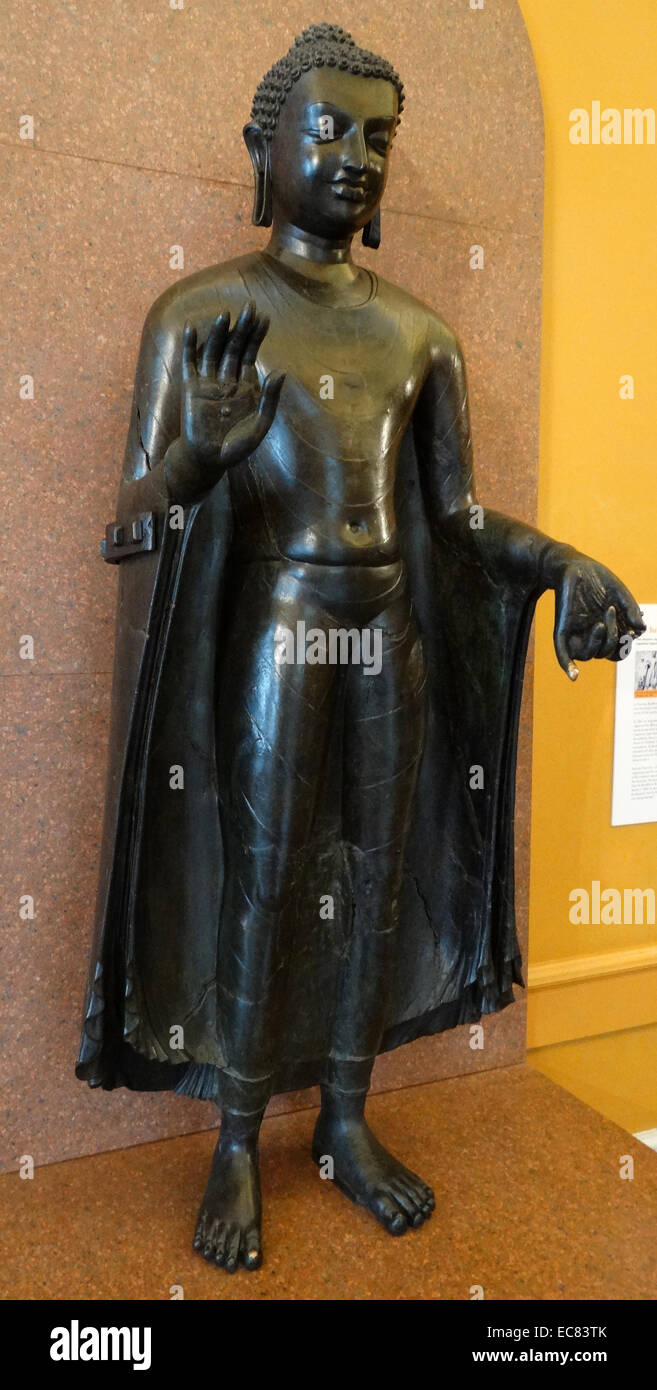 The Sultanganj Buddha. This statue was cast from copper during the Gupta period (320-650 AD) in Bihar; north India. Stock Photohttps://www.alamy.com/image-license-details/?v=1https://www.alamy.com/stock-photo-the-sultanganj-buddha-this-statue-was-cast-from-copper-during-the-76396003.html
The Sultanganj Buddha. This statue was cast from copper during the Gupta period (320-650 AD) in Bihar; north India. Stock Photohttps://www.alamy.com/image-license-details/?v=1https://www.alamy.com/stock-photo-the-sultanganj-buddha-this-statue-was-cast-from-copper-during-the-76396003.htmlRMEC83TK–The Sultanganj Buddha. This statue was cast from copper during the Gupta period (320-650 AD) in Bihar; north India.
 The Sultanganj Buddha, 500-700. Artist unknown.. Cast by the lost-wax technique on a clay core, this 6th to 7th Century bronze statue was excavated by E B Harris, a railway engineer, at Sultanganj, the state of Bihar, in northern India during the course of railway construction in 1862. Stock Photohttps://www.alamy.com/image-license-details/?v=1https://www.alamy.com/the-sultanganj-buddha-500-700-artist-unknown-cast-by-the-lost-wax-technique-on-a-clay-core-this-6th-to-7th-century-bronze-statue-was-excavated-by-e-b-harris-a-railway-engineer-at-sultanganj-the-state-of-bihar-in-northern-india-during-the-course-of-railway-construction-in-1862-image551006962.html
The Sultanganj Buddha, 500-700. Artist unknown.. Cast by the lost-wax technique on a clay core, this 6th to 7th Century bronze statue was excavated by E B Harris, a railway engineer, at Sultanganj, the state of Bihar, in northern India during the course of railway construction in 1862. Stock Photohttps://www.alamy.com/image-license-details/?v=1https://www.alamy.com/the-sultanganj-buddha-500-700-artist-unknown-cast-by-the-lost-wax-technique-on-a-clay-core-this-6th-to-7th-century-bronze-statue-was-excavated-by-e-b-harris-a-railway-engineer-at-sultanganj-the-state-of-bihar-in-northern-india-during-the-course-of-railway-construction-in-1862-image551006962.htmlRM2R0CF02–The Sultanganj Buddha, 500-700. Artist unknown.. Cast by the lost-wax technique on a clay core, this 6th to 7th Century bronze statue was excavated by E B Harris, a railway engineer, at Sultanganj, the state of Bihar, in northern India during the course of railway construction in 1862.
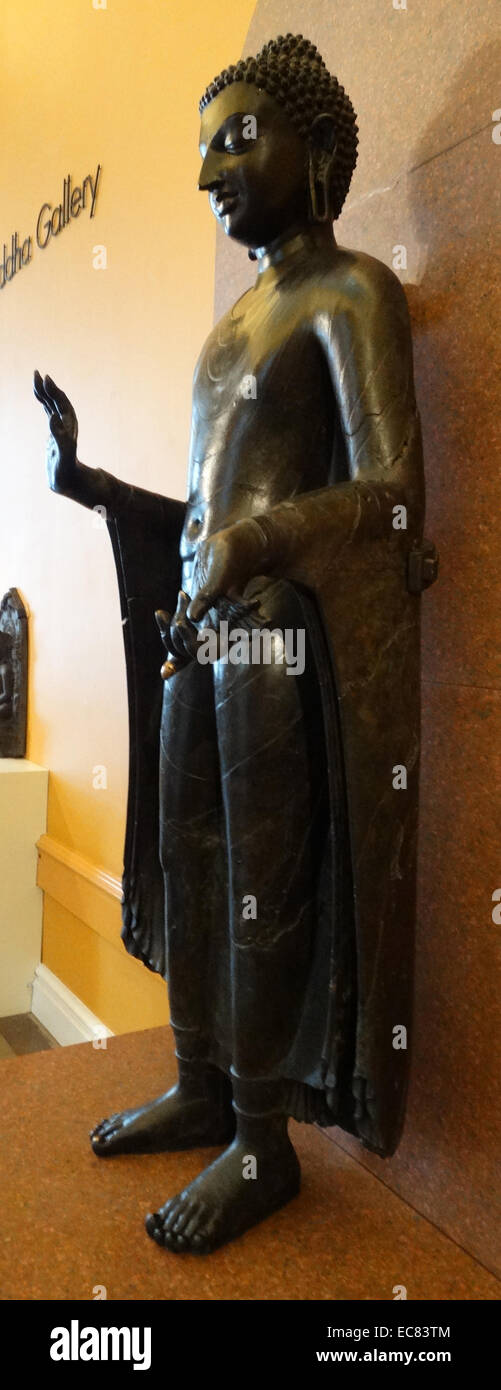 The Sultanganj Buddha. This statue was cast from copper during the Gupta period (320-650 AD) in Bihar; north India. Stock Photohttps://www.alamy.com/image-license-details/?v=1https://www.alamy.com/stock-photo-the-sultanganj-buddha-this-statue-was-cast-from-copper-during-the-76396004.html
The Sultanganj Buddha. This statue was cast from copper during the Gupta period (320-650 AD) in Bihar; north India. Stock Photohttps://www.alamy.com/image-license-details/?v=1https://www.alamy.com/stock-photo-the-sultanganj-buddha-this-statue-was-cast-from-copper-during-the-76396004.htmlRMEC83TM–The Sultanganj Buddha. This statue was cast from copper during the Gupta period (320-650 AD) in Bihar; north India.
 The Sultanganj Buddha, 500-700. Artist unknown.. Cast by the lost-wax technique on a clay core, this 6th to 7th Century bronze statue was excavated by E B Harris, a railway engineer, at Sultanganj, the state of Bihar, in northern India during the course of railway construction in 1862. Stock Photohttps://www.alamy.com/image-license-details/?v=1https://www.alamy.com/the-sultanganj-buddha-500-700-artist-unknown-cast-by-the-lost-wax-technique-on-a-clay-core-this-6th-to-7th-century-bronze-statue-was-excavated-by-e-b-harris-a-railway-engineer-at-sultanganj-the-state-of-bihar-in-northern-india-during-the-course-of-railway-construction-in-1862-image551002611.html
The Sultanganj Buddha, 500-700. Artist unknown.. Cast by the lost-wax technique on a clay core, this 6th to 7th Century bronze statue was excavated by E B Harris, a railway engineer, at Sultanganj, the state of Bihar, in northern India during the course of railway construction in 1862. Stock Photohttps://www.alamy.com/image-license-details/?v=1https://www.alamy.com/the-sultanganj-buddha-500-700-artist-unknown-cast-by-the-lost-wax-technique-on-a-clay-core-this-6th-to-7th-century-bronze-statue-was-excavated-by-e-b-harris-a-railway-engineer-at-sultanganj-the-state-of-bihar-in-northern-india-during-the-course-of-railway-construction-in-1862-image551002611.htmlRM2R0C9CK–The Sultanganj Buddha, 500-700. Artist unknown.. Cast by the lost-wax technique on a clay core, this 6th to 7th Century bronze statue was excavated by E B Harris, a railway engineer, at Sultanganj, the state of Bihar, in northern India during the course of railway construction in 1862.
 The Sultanganj Buddha, 500-700. Artist unknown.. Cast by the lost-wax technique on a clay core, this 6th to 7th Century bronze statue was excavated by E B Harris, a railway engineer, at Sultanganj, the state of Bihar, in northern India during the course of railway construction in 1862. Stock Photohttps://www.alamy.com/image-license-details/?v=1https://www.alamy.com/the-sultanganj-buddha-500-700-artist-unknown-cast-by-the-lost-wax-technique-on-a-clay-core-this-6th-to-7th-century-bronze-statue-was-excavated-by-e-b-harris-a-railway-engineer-at-sultanganj-the-state-of-bihar-in-northern-india-during-the-course-of-railway-construction-in-1862-image551003555.html
The Sultanganj Buddha, 500-700. Artist unknown.. Cast by the lost-wax technique on a clay core, this 6th to 7th Century bronze statue was excavated by E B Harris, a railway engineer, at Sultanganj, the state of Bihar, in northern India during the course of railway construction in 1862. Stock Photohttps://www.alamy.com/image-license-details/?v=1https://www.alamy.com/the-sultanganj-buddha-500-700-artist-unknown-cast-by-the-lost-wax-technique-on-a-clay-core-this-6th-to-7th-century-bronze-statue-was-excavated-by-e-b-harris-a-railway-engineer-at-sultanganj-the-state-of-bihar-in-northern-india-during-the-course-of-railway-construction-in-1862-image551003555.htmlRM2R0CAJB–The Sultanganj Buddha, 500-700. Artist unknown.. Cast by the lost-wax technique on a clay core, this 6th to 7th Century bronze statue was excavated by E B Harris, a railway engineer, at Sultanganj, the state of Bihar, in northern India during the course of railway construction in 1862.
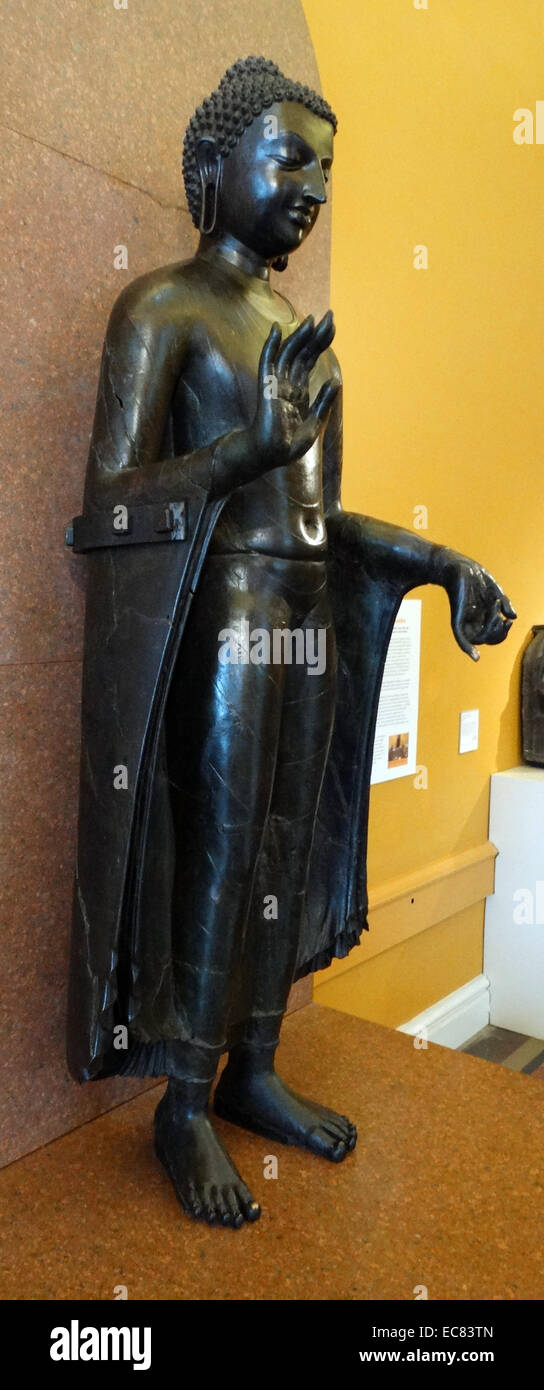 The Sultanganj Buddha. This statue was cast from copper during the Gupta period (320-650 AD) in Bihar; north India. Stock Photohttps://www.alamy.com/image-license-details/?v=1https://www.alamy.com/stock-photo-the-sultanganj-buddha-this-statue-was-cast-from-copper-during-the-76396005.html
The Sultanganj Buddha. This statue was cast from copper during the Gupta period (320-650 AD) in Bihar; north India. Stock Photohttps://www.alamy.com/image-license-details/?v=1https://www.alamy.com/stock-photo-the-sultanganj-buddha-this-statue-was-cast-from-copper-during-the-76396005.htmlRMEC83TN–The Sultanganj Buddha. This statue was cast from copper during the Gupta period (320-650 AD) in Bihar; north India.
 The Sultanganj Buddha, 500-700. Artist unknown.. Cast by the lost-wax technique on a clay core, this 6th to 7th Century bronze statue was excavated by E B Harris, a railway engineer, at Sultanganj, the state of Bihar, in northern India during the course of railway construction in 1862. Stock Photohttps://www.alamy.com/image-license-details/?v=1https://www.alamy.com/the-sultanganj-buddha-500-700-artist-unknown-cast-by-the-lost-wax-technique-on-a-clay-core-this-6th-to-7th-century-bronze-statue-was-excavated-by-e-b-harris-a-railway-engineer-at-sultanganj-the-state-of-bihar-in-northern-india-during-the-course-of-railway-construction-in-1862-image551002550.html
The Sultanganj Buddha, 500-700. Artist unknown.. Cast by the lost-wax technique on a clay core, this 6th to 7th Century bronze statue was excavated by E B Harris, a railway engineer, at Sultanganj, the state of Bihar, in northern India during the course of railway construction in 1862. Stock Photohttps://www.alamy.com/image-license-details/?v=1https://www.alamy.com/the-sultanganj-buddha-500-700-artist-unknown-cast-by-the-lost-wax-technique-on-a-clay-core-this-6th-to-7th-century-bronze-statue-was-excavated-by-e-b-harris-a-railway-engineer-at-sultanganj-the-state-of-bihar-in-northern-india-during-the-course-of-railway-construction-in-1862-image551002550.htmlRM2R0C9AE–The Sultanganj Buddha, 500-700. Artist unknown.. Cast by the lost-wax technique on a clay core, this 6th to 7th Century bronze statue was excavated by E B Harris, a railway engineer, at Sultanganj, the state of Bihar, in northern India during the course of railway construction in 1862.
 The Sultanganj Buddha, 500-700. Artist unknown.. Cast by the lost-wax technique on a clay core, this 6th to 7th Century bronze statue was excavated by E B Harris, a railway engineer, at Sultanganj, the state of Bihar, in northern India during the course of railway construction in 1862. Stock Photohttps://www.alamy.com/image-license-details/?v=1https://www.alamy.com/the-sultanganj-buddha-500-700-artist-unknown-cast-by-the-lost-wax-technique-on-a-clay-core-this-6th-to-7th-century-bronze-statue-was-excavated-by-e-b-harris-a-railway-engineer-at-sultanganj-the-state-of-bihar-in-northern-india-during-the-course-of-railway-construction-in-1862-image551002738.html
The Sultanganj Buddha, 500-700. Artist unknown.. Cast by the lost-wax technique on a clay core, this 6th to 7th Century bronze statue was excavated by E B Harris, a railway engineer, at Sultanganj, the state of Bihar, in northern India during the course of railway construction in 1862. Stock Photohttps://www.alamy.com/image-license-details/?v=1https://www.alamy.com/the-sultanganj-buddha-500-700-artist-unknown-cast-by-the-lost-wax-technique-on-a-clay-core-this-6th-to-7th-century-bronze-statue-was-excavated-by-e-b-harris-a-railway-engineer-at-sultanganj-the-state-of-bihar-in-northern-india-during-the-course-of-railway-construction-in-1862-image551002738.htmlRM2R0C9H6–The Sultanganj Buddha, 500-700. Artist unknown.. Cast by the lost-wax technique on a clay core, this 6th to 7th Century bronze statue was excavated by E B Harris, a railway engineer, at Sultanganj, the state of Bihar, in northern India during the course of railway construction in 1862.
 The Sultanganj Buddha, 500-700. Artist unknown.. Cast by the lost-wax technique on a clay core, this 6th to 7th Century bronze statue was excavated by E B Harris, a railway engineer, at Sultanganj, the state of Bihar,. in northern India during the course of railway construction in 1862. Stock Photohttps://www.alamy.com/image-license-details/?v=1https://www.alamy.com/the-sultanganj-buddha-500-700-artist-unknown-cast-by-the-lost-wax-technique-on-a-clay-core-this-6th-to-7th-century-bronze-statue-was-excavated-by-e-b-harris-a-railway-engineer-at-sultanganj-the-state-of-bihar-in-northern-india-during-the-course-of-railway-construction-in-1862-image551002729.html
The Sultanganj Buddha, 500-700. Artist unknown.. Cast by the lost-wax technique on a clay core, this 6th to 7th Century bronze statue was excavated by E B Harris, a railway engineer, at Sultanganj, the state of Bihar,. in northern India during the course of railway construction in 1862. Stock Photohttps://www.alamy.com/image-license-details/?v=1https://www.alamy.com/the-sultanganj-buddha-500-700-artist-unknown-cast-by-the-lost-wax-technique-on-a-clay-core-this-6th-to-7th-century-bronze-statue-was-excavated-by-e-b-harris-a-railway-engineer-at-sultanganj-the-state-of-bihar-in-northern-india-during-the-course-of-railway-construction-in-1862-image551002729.htmlRM2R0C9GW–The Sultanganj Buddha, 500-700. Artist unknown.. Cast by the lost-wax technique on a clay core, this 6th to 7th Century bronze statue was excavated by E B Harris, a railway engineer, at Sultanganj, the state of Bihar,. in northern India during the course of railway construction in 1862.
 The Sultanganj Buddha, 500-700. Artist unknown.. Cast by the lost-wax technique on a clay core, this 6th to 7th Century bronze statue was excavated by E B Harris, a railway engineer, at Sultanganj, the state of Bihar, in northern India during the course of railway construction in 1862. Stock Photohttps://www.alamy.com/image-license-details/?v=1https://www.alamy.com/the-sultanganj-buddha-500-700-artist-unknown-cast-by-the-lost-wax-technique-on-a-clay-core-this-6th-to-7th-century-bronze-statue-was-excavated-by-e-b-harris-a-railway-engineer-at-sultanganj-the-state-of-bihar-in-northern-india-during-the-course-of-railway-construction-in-1862-image551008615.html
The Sultanganj Buddha, 500-700. Artist unknown.. Cast by the lost-wax technique on a clay core, this 6th to 7th Century bronze statue was excavated by E B Harris, a railway engineer, at Sultanganj, the state of Bihar, in northern India during the course of railway construction in 1862. Stock Photohttps://www.alamy.com/image-license-details/?v=1https://www.alamy.com/the-sultanganj-buddha-500-700-artist-unknown-cast-by-the-lost-wax-technique-on-a-clay-core-this-6th-to-7th-century-bronze-statue-was-excavated-by-e-b-harris-a-railway-engineer-at-sultanganj-the-state-of-bihar-in-northern-india-during-the-course-of-railway-construction-in-1862-image551008615.htmlRM2R0CH33–The Sultanganj Buddha, 500-700. Artist unknown.. Cast by the lost-wax technique on a clay core, this 6th to 7th Century bronze statue was excavated by E B Harris, a railway engineer, at Sultanganj, the state of Bihar, in northern India during the course of railway construction in 1862.
 The Sultanganj Buddha, 500-700. Artist unknown.. Cast by the lost-wax technique on a clay core, this 6th to 7th Century bronze statue was excavated by E B Harris, a railway engineer, at Sultanganj, the state of Bihar, in northern India during the course of railway construction in 1862. Stock Photohttps://www.alamy.com/image-license-details/?v=1https://www.alamy.com/the-sultanganj-buddha-500-700-artist-unknown-cast-by-the-lost-wax-technique-on-a-clay-core-this-6th-to-7th-century-bronze-statue-was-excavated-by-e-b-harris-a-railway-engineer-at-sultanganj-the-state-of-bihar-in-northern-india-during-the-course-of-railway-construction-in-1862-image551002864.html
The Sultanganj Buddha, 500-700. Artist unknown.. Cast by the lost-wax technique on a clay core, this 6th to 7th Century bronze statue was excavated by E B Harris, a railway engineer, at Sultanganj, the state of Bihar, in northern India during the course of railway construction in 1862. Stock Photohttps://www.alamy.com/image-license-details/?v=1https://www.alamy.com/the-sultanganj-buddha-500-700-artist-unknown-cast-by-the-lost-wax-technique-on-a-clay-core-this-6th-to-7th-century-bronze-statue-was-excavated-by-e-b-harris-a-railway-engineer-at-sultanganj-the-state-of-bihar-in-northern-india-during-the-course-of-railway-construction-in-1862-image551002864.htmlRM2R0C9NM–The Sultanganj Buddha, 500-700. Artist unknown.. Cast by the lost-wax technique on a clay core, this 6th to 7th Century bronze statue was excavated by E B Harris, a railway engineer, at Sultanganj, the state of Bihar, in northern India during the course of railway construction in 1862.
 The Sultanganj Buddha, 500-700. Artist unknown.. Cast by the lost-wax technique on a clay core, this 6th to 7th Century bronze statue was excavated by E B Harris, a railway engineer, at Sultanganj, the state of Bihar, in northern India during the course of railway construction in 1862. Stock Photohttps://www.alamy.com/image-license-details/?v=1https://www.alamy.com/the-sultanganj-buddha-500-700-artist-unknown-cast-by-the-lost-wax-technique-on-a-clay-core-this-6th-to-7th-century-bronze-statue-was-excavated-by-e-b-harris-a-railway-engineer-at-sultanganj-the-state-of-bihar-in-northern-india-during-the-course-of-railway-construction-in-1862-image551002549.html
The Sultanganj Buddha, 500-700. Artist unknown.. Cast by the lost-wax technique on a clay core, this 6th to 7th Century bronze statue was excavated by E B Harris, a railway engineer, at Sultanganj, the state of Bihar, in northern India during the course of railway construction in 1862. Stock Photohttps://www.alamy.com/image-license-details/?v=1https://www.alamy.com/the-sultanganj-buddha-500-700-artist-unknown-cast-by-the-lost-wax-technique-on-a-clay-core-this-6th-to-7th-century-bronze-statue-was-excavated-by-e-b-harris-a-railway-engineer-at-sultanganj-the-state-of-bihar-in-northern-india-during-the-course-of-railway-construction-in-1862-image551002549.htmlRM2R0C9AD–The Sultanganj Buddha, 500-700. Artist unknown.. Cast by the lost-wax technique on a clay core, this 6th to 7th Century bronze statue was excavated by E B Harris, a railway engineer, at Sultanganj, the state of Bihar, in northern India during the course of railway construction in 1862.
 The Sultanganj Buddha, 500-700. Artist unknown.. Cast by the lost-wax technique on a clay core, this 6th to 7th Century bronze statue was excavated by E B Harris, a railway engineer, at Sultanganj, the state of Bihar, in northern India during the course of railway construction in 1862. Stock Photohttps://www.alamy.com/image-license-details/?v=1https://www.alamy.com/the-sultanganj-buddha-500-700-artist-unknown-cast-by-the-lost-wax-technique-on-a-clay-core-this-6th-to-7th-century-bronze-statue-was-excavated-by-e-b-harris-a-railway-engineer-at-sultanganj-the-state-of-bihar-in-northern-india-during-the-course-of-railway-construction-in-1862-image551003553.html
The Sultanganj Buddha, 500-700. Artist unknown.. Cast by the lost-wax technique on a clay core, this 6th to 7th Century bronze statue was excavated by E B Harris, a railway engineer, at Sultanganj, the state of Bihar, in northern India during the course of railway construction in 1862. Stock Photohttps://www.alamy.com/image-license-details/?v=1https://www.alamy.com/the-sultanganj-buddha-500-700-artist-unknown-cast-by-the-lost-wax-technique-on-a-clay-core-this-6th-to-7th-century-bronze-statue-was-excavated-by-e-b-harris-a-railway-engineer-at-sultanganj-the-state-of-bihar-in-northern-india-during-the-course-of-railway-construction-in-1862-image551003553.htmlRM2R0CAJ9–The Sultanganj Buddha, 500-700. Artist unknown.. Cast by the lost-wax technique on a clay core, this 6th to 7th Century bronze statue was excavated by E B Harris, a railway engineer, at Sultanganj, the state of Bihar, in northern India during the course of railway construction in 1862.
 Moving the Sultanganj Buddha at Birmingham Museum and Art Gallery, exact date. not known, 1970s... 1885A1116. The Sultanganj Buddha, 500-700. Artist unknown.. Cast by the lost-wax technique on a clay core, this 6th to 7th Century bronze statue was excavated by E B Harris, a railway engineer, at Sultanganj, the state of Bihar, in northern India during the course of railway construction in 1862. Stock Photohttps://www.alamy.com/image-license-details/?v=1https://www.alamy.com/moving-the-sultanganj-buddha-at-birmingham-museum-and-art-gallery-exact-date-not-known-1970s-1885a1116-the-sultanganj-buddha-500-700-artist-unknown-cast-by-the-lost-wax-technique-on-a-clay-core-this-6th-to-7th-century-bronze-statue-was-excavated-by-e-b-harris-a-railway-engineer-at-sultanganj-the-state-of-bihar-in-northern-india-during-the-course-of-railway-construction-in-1862-image551004494.html
Moving the Sultanganj Buddha at Birmingham Museum and Art Gallery, exact date. not known, 1970s... 1885A1116. The Sultanganj Buddha, 500-700. Artist unknown.. Cast by the lost-wax technique on a clay core, this 6th to 7th Century bronze statue was excavated by E B Harris, a railway engineer, at Sultanganj, the state of Bihar, in northern India during the course of railway construction in 1862. Stock Photohttps://www.alamy.com/image-license-details/?v=1https://www.alamy.com/moving-the-sultanganj-buddha-at-birmingham-museum-and-art-gallery-exact-date-not-known-1970s-1885a1116-the-sultanganj-buddha-500-700-artist-unknown-cast-by-the-lost-wax-technique-on-a-clay-core-this-6th-to-7th-century-bronze-statue-was-excavated-by-e-b-harris-a-railway-engineer-at-sultanganj-the-state-of-bihar-in-northern-india-during-the-course-of-railway-construction-in-1862-image551004494.htmlRM2R0CBRX–Moving the Sultanganj Buddha at Birmingham Museum and Art Gallery, exact date. not known, 1970s... 1885A1116. The Sultanganj Buddha, 500-700. Artist unknown.. Cast by the lost-wax technique on a clay core, this 6th to 7th Century bronze statue was excavated by E B Harris, a railway engineer, at Sultanganj, the state of Bihar, in northern India during the course of railway construction in 1862.